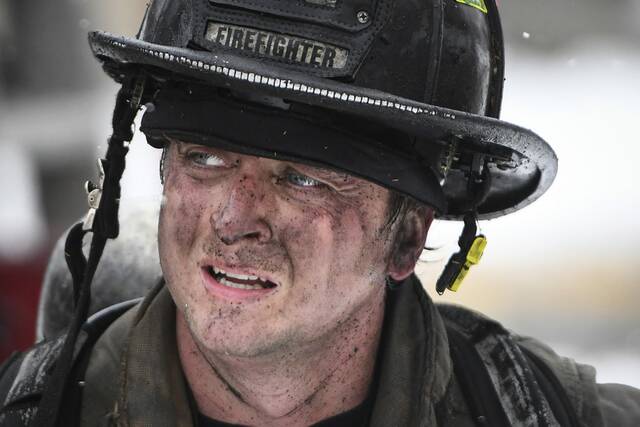Jonathan Sharp: Protecting our firefighters from dangerous chemicals
Firefighters , the brave people who risk their lives to protect their communities, are regularly exposed to countless toxic substances while extinguishing blazes, including formaldehyde, hydrogen cyanide, benzene, asbestos, polychlorinated biphenyls, smoke, carbon monoxide and perfluoroalkyl and polyfluoroalkyl substances. Commonly known as PFAS or “forever chemicals” because of their persistence in the environment and the human body, these harmful substances are present in the fire suppressant aqueous film foaming form (AFFF) used by firefighters to put out fires stemming from combustible and flammable liquids and gases, such as lacquers, alcohol, jet fuel, petroleum and gasoline. “Forever chemicals” also are present in the turnout gear firefighters wear to shield themselves from extreme temperatures.
The Pittsburgh Bureau of Fire is the second largest fire department in Pennsylvania. It is composed of 30 fire stations and has 670 firefighters, receiving approximately 65,236 calls every year. On Oct. 27, an electric car’s lithium-ion battery may have ignited and caused a fire at a vehicle repair and service facility in Bloomfield. Fire units were called to a commercial structure fire in the 800 block of Gross Street at around 6:15 a.m. No one was hurt in the blaze, and the exact cause of the fire is still under investigation.
This is just one of the numerous examples of the relentless work of Pittsburgh firefighters. Unfortunately, they constantly face toxic exposure from the use of AFFF and from the PFAS that are released by their turnout gear. Exposure to “forever chemicals” is responsible for prostate, kidney and testicular cancer.
Turnout gear is made of three layers: a thermal liner close to the skin, a moisture barrier and a water-repellent outer shell. According to a May 2023 report, PFAS concentrations were lowest on the gear closest to firefighters’ skin and highest on the outer second and third layers. The moisture barrier and the outer shell contained “forever chemicals” concentrations up to 400 times higher than the thermal liner. PFAS are a major component of the moisture barrier of turnout gear.
Since 2022, most manufacturers have been offering PFAS-free, durable water-repellent finishes, but the expanded-polytetrafluoroethylene moisture barrier still contains and releases these dangerous substances, which only contributes to toxic exposure among firefighters. They have a 9% higher risk of developing cancer and a 14% greater risk of dying from it.
The situation might change in the near future, as on July 20, the PFAS Alternatives Act was introduced by U.S. Rep. Brian Fitzpatrick, R-Bucks County. If this bill is signed into law, it would facilitate the development of safer turnout gear materials, speed up the development of PFAS-free turnout gear, and support guidance and training for firefighters on the most effective practices for reducing harmful exposures on the job.
Furthermore, the PFAS Alternatives Act would authorize $25 million annually for each fiscal year from 2024 to 2028 to support the development of new materials and $2 million every year to support guidance and training.
“Firefighters put their health and safety on the line every day to protect our communities. They run in as others run out. They shouldn’t have to worry about hazardous substances in their own turnout gear,” said U.S. Rep. Dina Titus, D-Nevada.
At the moment, manufacturers of turnout gear use “forever chemicals” because of a lack of more effective alternatives. The characteristics of PFAS can impart water and oil resistance to fabrics, which is why they are used to help firefighting gear meet the safety standards of the National Fire Protection Association Standard on Protective Ensembles for Structural Fire Fighting and Proximity Fire Fighting criteria for resistance to heat, water and other hazards.
The May 2023 study concluded that selecting optimal combinations of fabrics for every layer of turnout gear could considerably reduce the amount of PFAS existent in firefighters’ turnout gear. “If you changed to a non-PFAS water repellant coating on the outer shell, then you essentially eliminate PFAS from that layer. There isn’t much in the thermal liner to begin with. So really the one layer left to address is the moisture barrier,” said NIST researcher Rick Davis.
If the PFAS Alternatives Act became law, firefighters’ toxic exposure would be reduced a significant extent, and we might also witness a decrease in the alarming rate of cancer occurring in this occupational group.
Not only can “forever chemicals” exposure cause cancer, but it also can result in high cholesterol, fertility issues, kidney disease, altered immune function, liver damage, thyroid disease and preeclampsia in pregnant women.
Minimizing PFAS exposure is what ultimately needs to happen in order to protect the health of these courageous people.
Jonathan Sharp is chief financial officer at Environmental Litigation Group, a Birmingham, Ala. law firm offers that assistance to civilian and military firefighters affected by toxic exposure on the job or during active duty.
Remove the ads from your TribLIVE reading experience but still support the journalists who create the content with TribLIVE Ad-Free.

